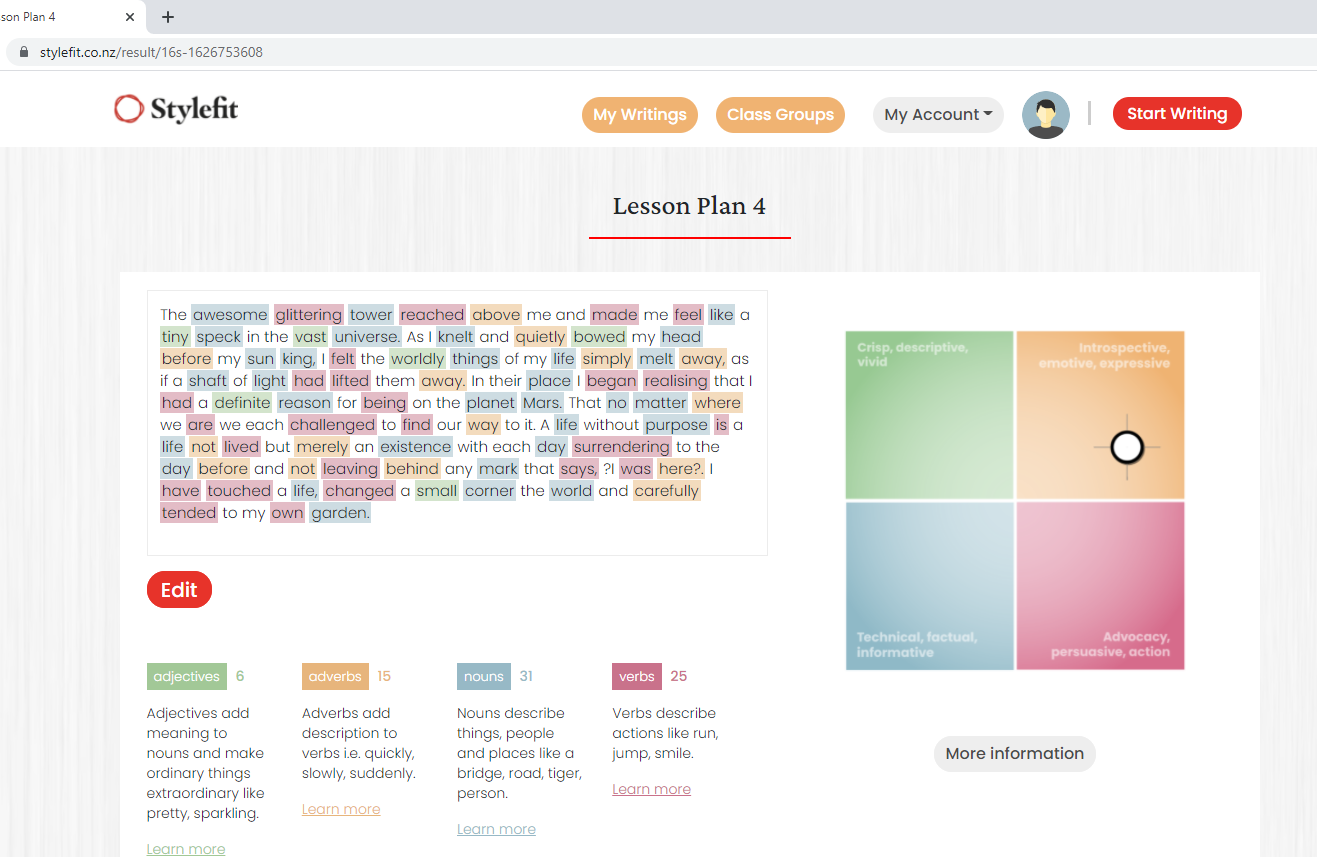Lesson Plan for Year 7-8
Using Stylefit – an interactive writing tool that encourages critical thinking, self-directed learning and classroom engagement.
An Introduction
Stylefit is interactive technology that teaches students how words interact. Visual feedback shows the breakdown of their writing and explains what happens if they change it. Stylefit encourages self-directed and collaborative learning.
Best of all, it takes just seconds for students to receive feedback so they can get to work editing and making changes to their writing straight away.
Nouns (blue), Verbs (pink), Adjectives (green) and adverbs (adverbs).
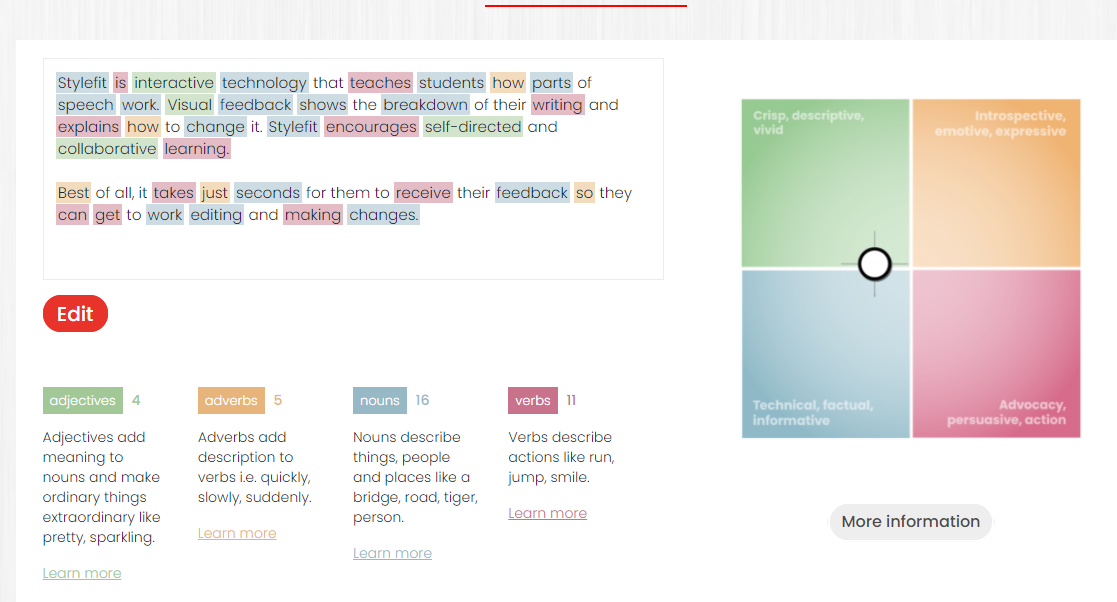
It meets the following curriculum criteria:
- Understand passive versus active voice
- Understand how parts of speech work
- Writing for an audience
- Increases vocabulary
- Encourages descriptive writing
- Encourages editing and writing more than one draft
To find out more go to: www.stylefit.org
Lesson Plan
The following exercises use Stylefit to encourage students to write in a variety of styles. The first exercise is to use description. The second to report on an event that occurred in a cave. The third is to write a creative story and the fourth is to be imaginative and emotive. Each piece should land in each of the quadrants of Stylefit. A fifth exercise would be to write a persuasive piece.
Exercise 1: Description (exposition)
You have been asked by the editor of a travel magazine to write an article about the cave in the picture. It is famous and the town where it is located want you to get visitors to come to the town to see it.
Questions to ask:
- Why should anyone visit it?
- Where is it?
- What is special about it?
- How do you feel about this place?
- Any stories associated with it?
- How do people get to it?

Secret: use adjectives
| What do you see? | What do you hear? | Why visit? | How do I feel? | Stories |
| A cave resembling a dinosaur | Silence | It’s the only one of its kind in the world | Fascinated | Legend of a runaway convict |
| Interesting light forms and shadows | Maybe people talking | I love exploring caves (my job) | a bit spooked | Hid there for months |
| What might I overhear | How to get to it |
Exemplar
Go back to an era where dinosaurs roamed the earth and explore the famous Jurassic Cave. Every year thousands of Espluners (cave explorers) visit this unique cave to see its fascinating formations. Inside, there are stalagmites and stalagtites that resemble creatures from the Jurassic age.
Descend into the deep, dark bowels of this cave where a myriad glow worms put on an outstanding show, Remember to be quiet though. Glow worms put out their lights when visitors make a lot of noise.
The rock formations are beautiful, with schist forming unusually linear patterns.
I have been down there many times as a visitor guide. The first time was a bit spooky so if you enjoy a bit of a spine tingling experience, Jurassic cave is definitely the place to visit. There is nothing to be afraid off. We do guarantee your safety. Relax and enjoy the experience.
Every visitor who has come here has only good things to say regarding their experience. In fact we get friends of former visitors arriving the next year on their recommendation.
Sir Richard Thomas, a famous cave explorer said these caves were the most splendid he had ever seen in the world. They were perfect examples of extensive lime stone caves. His crew from Japan agreed after spending several days exploring the cave’s many paths and internal grottos. He said it was the most amazing formation of caves he had ever seen.
You can see what he was talking about by joining our next tour in July.
Remember to wear warm clothes and sturdy shoes.
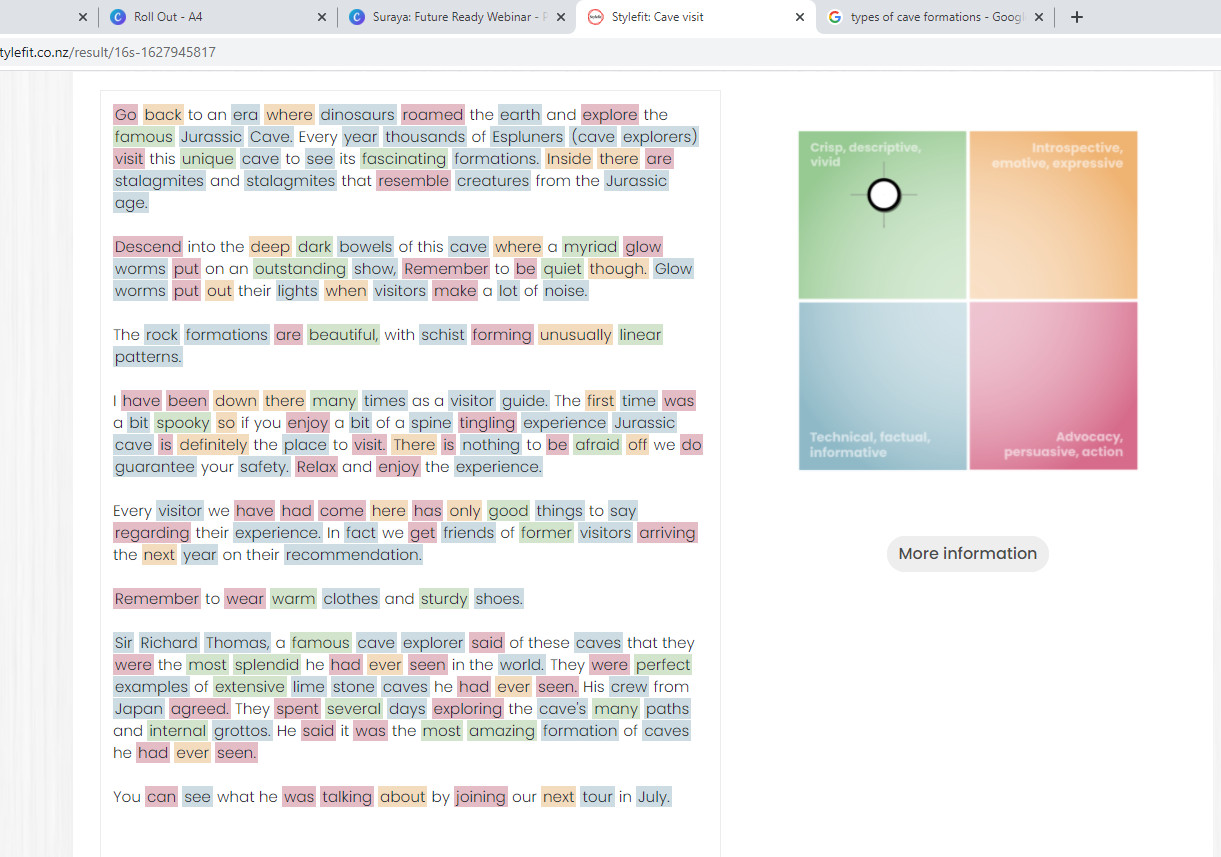
Exemplar
Maria felt the ground fall from under her feet. Her terrified scream echoed as she flew down a dark, dank hole in the ground. She bumped against rock walls and bounced, yelping from one side to the other. The sound of tearing material as the rocks shredded her clothes made her stomach lurch. She landed with a muffled thump on the damp dirt and lay, for a few minutes, winded and afraid.
The dark shadow of a tiny bat flicked her cheek. She squealed then curled, trembling, in a tight ball. Sunlight shone through a gap at the top. It was a long way away. With sinking heart she noticed that the jutting bits of rock wall that had cut her were too small to act as steps so she could climb out.
“Somebody help me!”
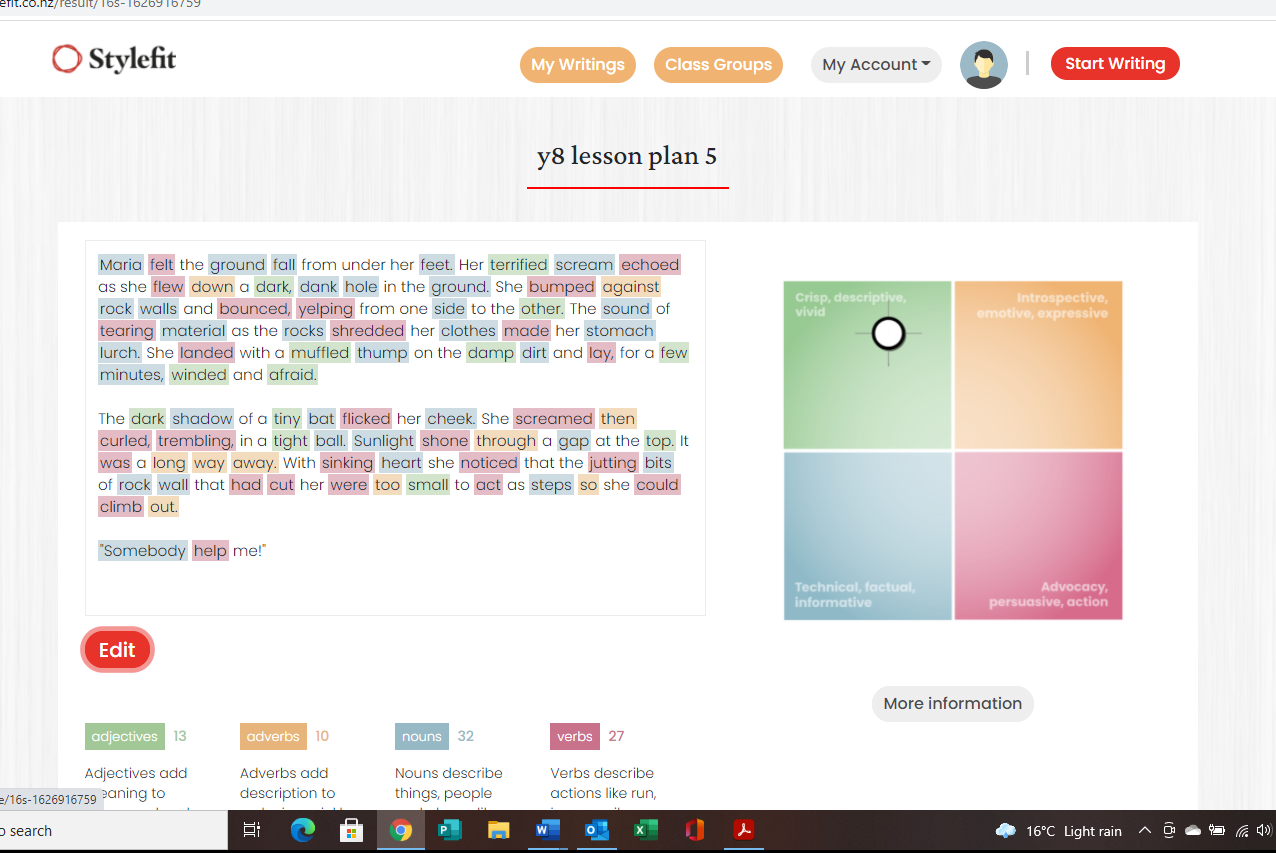
- It is descriptive.
- Words describe sensation like the bat flicking her cheek.
- It uses alliteration – dark dank.
- It is visual.
- Adjectives qualify elements. The bat is tiny for example.
Write up to 300 words describing the image.
This can be a description for a magazine that promotes places for travellers to visit. Non-fiction.
Exercise 2: Report/Essay
In this exercise write a report about an incident that happened in the cave.
You are writing a report for a newspaper telling the reader:
- What happened.
- What the outcome was.
- Where it was.
- Why it happened.
- How it happened.
- Add any other important information.

| Where it was/Who |
What happened | How it happened | Why it happened | Outcome |
| In the countryside | Fell into a cave covered with bracken | Danny and Rachel were talking. | Council had forgotten to remove a barrier. | Fenced off now. |
| Children, aged 8 and 10 | Lost for half a day and into the night | Rescued by the Fire Brigade. |
Two children fell down this cave.
Exemplar
As a reporter you are reporting on the incident.
Two children, Danny (8) and Rachel (10) were lost for 24 hours. A large search and rescue party, including a helicopter, were out all night searching for them.
The search party found they had fallen into a fissure in the ground which Council said was caused by a recent earthquake in the area.
The children were unhurt but cold. They are recovering in hospital in a stable condition.
Council says they will put a barrier around the fissure so that there are no further incidents.
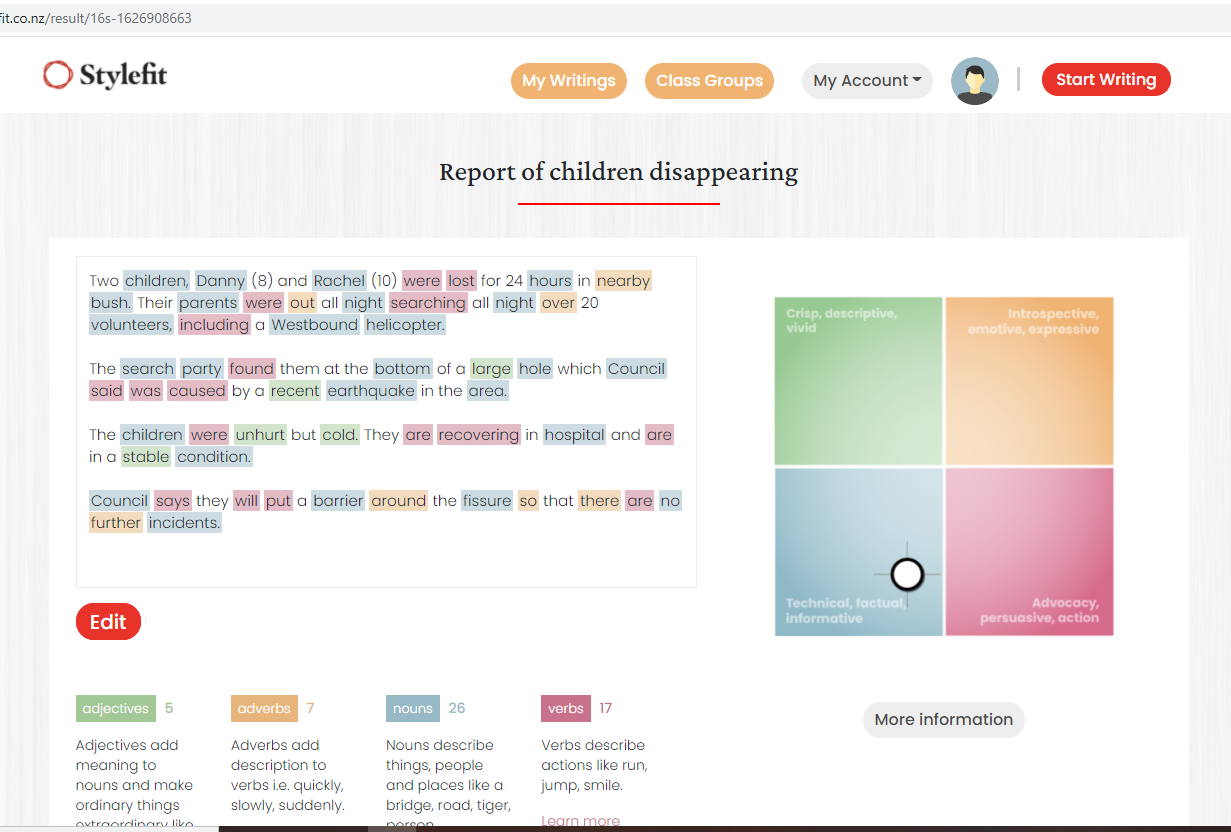
- It gives facts, not emotions.
- Minimal action.
- We don’t hear about how the children felt nor what they did.
- They are not described apart from their ages and what happened to them.
- It is high in nouns, low in adverbs and adjectives.
- It is short and to the point.
Exercise 3: Story (creative writing)
This image could be used in many ways to write a creative story. The way the light falls suggests a Tyrannosaurus. So, your story could be about a Tyrannosaurus.
However, I have written a plan for a story about two children going out to look for gold and falling down a mine shaft.
In this story you use your imagination and add action.
The questions to ask are:
- What happened?
- Who to?
- Why did it happen and how?
- Why were they looking for gold?
- When did it happen?
- How did the story end?
Remember the story arc
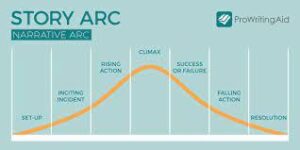

| Who |
What |
How |
Why |
Where/when |
| Two children | Tourists | One falls down an old mine shaft | Danny and Rachel rescue them | Waihi |
Exemplar
Rachel and Danny’s Adventure
Rachel and Danny lived in a former gold mining town. Busloads of tourists regularly stopped by to look at the historic mine shafts. As they walked across the field towards a famous mine shaft, they could see a group of people talking and pointing down at the ground.
Puzzled, Rachel and Danny stopped.
“I wonder why they are there and not with the other group?” Rachel muttered.
“I suppose they wanted to explore,” Danny replied.
Curious, they walked through the dry grass and joined the group. Two of the group were crying.
“What’s wrong?” Rachel asked.
The woman began sobbing. “Our friend has just fallen down that hole.”
She wailed. “She might be dead.”
A voice echoed up from the dark depths below.
“I am not dead. Get me out!”
Danny ran as fast as he could to the police station where his dad was in charge. Danny’s heart thumped with terror. He was trying not to cry.
His Dad knew it was serious accident. He called up the Rescue squad and they all drove sirens blaring to where the lady had fallen. By this time the crowd was at various stages of shock and terror. Many were crying as they crowded around the hole in the ground and peered down to where their friend lay.
Danny’s Dad held out his hands and told everyone to move back so the rescuer could be lowered down into the shaft. His boots thudded as he bounced of the rock face.
When he reached the woman, he tied her to the rope and the men gradually lifted her up. When she got to the surface everyone cheered. The ambulance officers put her on a stretcher and drove her to hospital.
Danny’s dad held out a hand to shake Danny’s and Rachel’s hands.
“Well done both of you. She could have died if we hadn’t got to her quickly.”
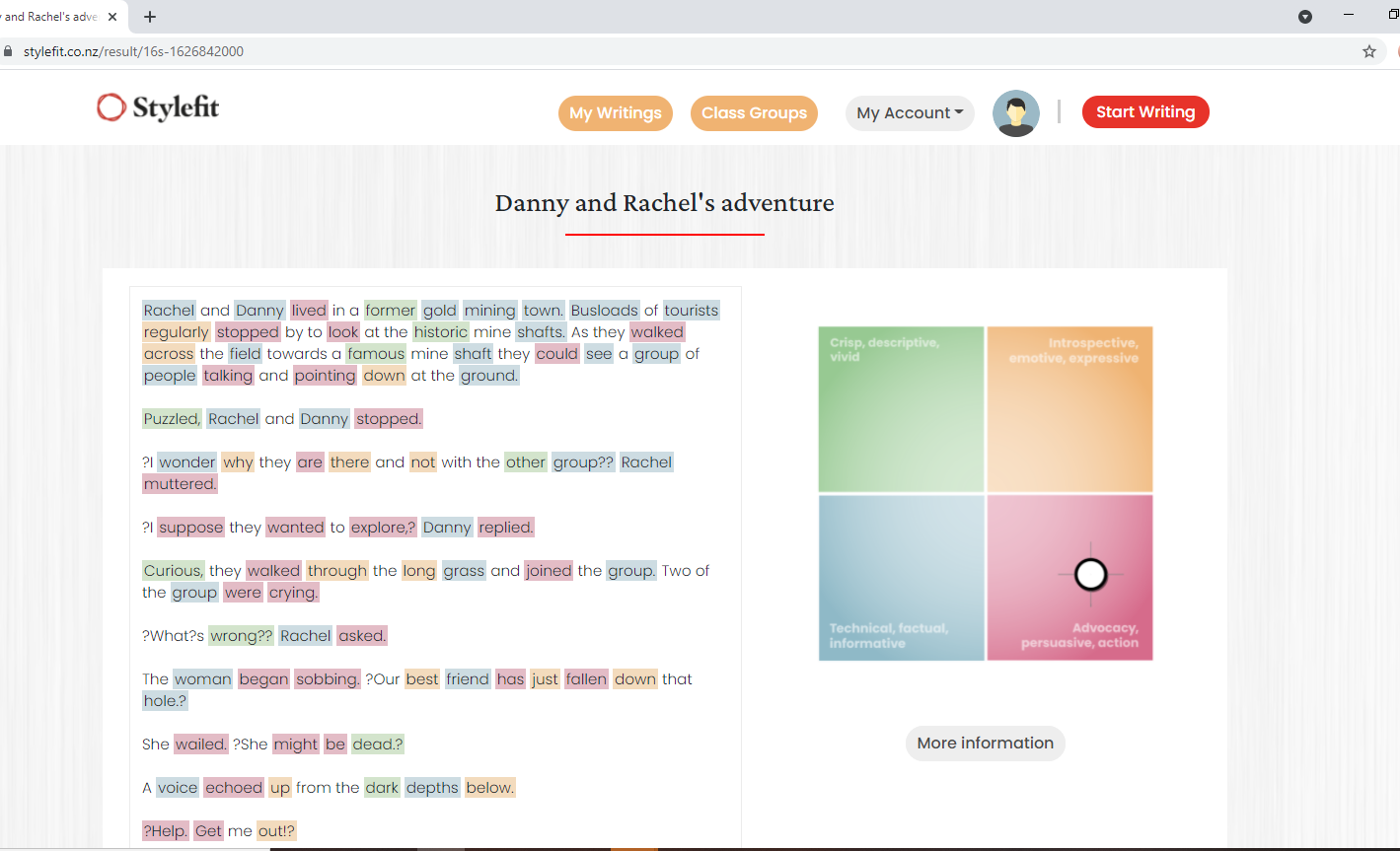
| Who |
What |
How |
Why |
Where/when |
| Two children | Tourists | One falls down an old mine shaft | Danny and Rachel rescue them | Waihi |
- This story uses verbs like ran, sobbing, joined, walked.
- They describe what Danny and Rachel are doing.
- We can see what is happening as if we are watching a television programme. This is an example of showing not telling.
- Adverbs tell us that tour buses often (that is not occasionally) stopped in their town.
- Adjectives like famous, historic add information about the mine.
- The story follows a natural story arc with the scene set in a town, followed by the action then a natural summary of what happened to the woman and the two friends at the end.
Exercise 4: Emotive/ Imaginative
This is an imaginative story, colourful and emotional. It could also be philosophical.
In this story you could be the hero. It works well if you use a personal pronoun.
You can speak from your heart and let your imagination create a world such as the one suggested by the image.
The questions to ask here are:
- Where is the world I want to create?
- What is it like?
- What meaning do I get from it?
- What do I want to say?
- How do I say it?
- What emotion do I want to express?

| Where |
What do I want to say |
How do I want to say it |
Who |
What emotion do I want to express |
| A fictitious world | That we need a purpose in life | As science fiction | Me | Awe |
- The adverbs add power to the sensation of the adjective awesome.
- Adverbs amplify the intensity of my action as in quietly bowed my head.
- Adverbs add the smallness of a life without purpose.
Adjectives also add power to the visual of the writers thoughts. - It is imaginative.
- It would fit into the genre of science fiction.
- It has an introduction. First paragraph. We are in a place with the character and we know that this is a reflective piece.
- It has a middle. We know what the writer is thinking and how he or she is reacting to the situation.
- It has an end. It summarises whay the writer is trying to say.
Exemplar
The awesome glittering tower reached above me and made me feel like a tiny speck in the vast universe.
As I knelt and quietly bowed my head before my sun king, I felt the worldly things of my life simply melt away, as if a shaft of light had lifted them away. In their place I began realising that I had a definite reason for being on the planet earth. That no matter where we are we are each challenged to find our way to it.
A life without purpose is a life not lived but merely an existence with each day surrendering to the day before and not leaving behind any mark that says, “I was here. I have touched a life, changed a small corner of the world and carefully tended to my own garden.”
